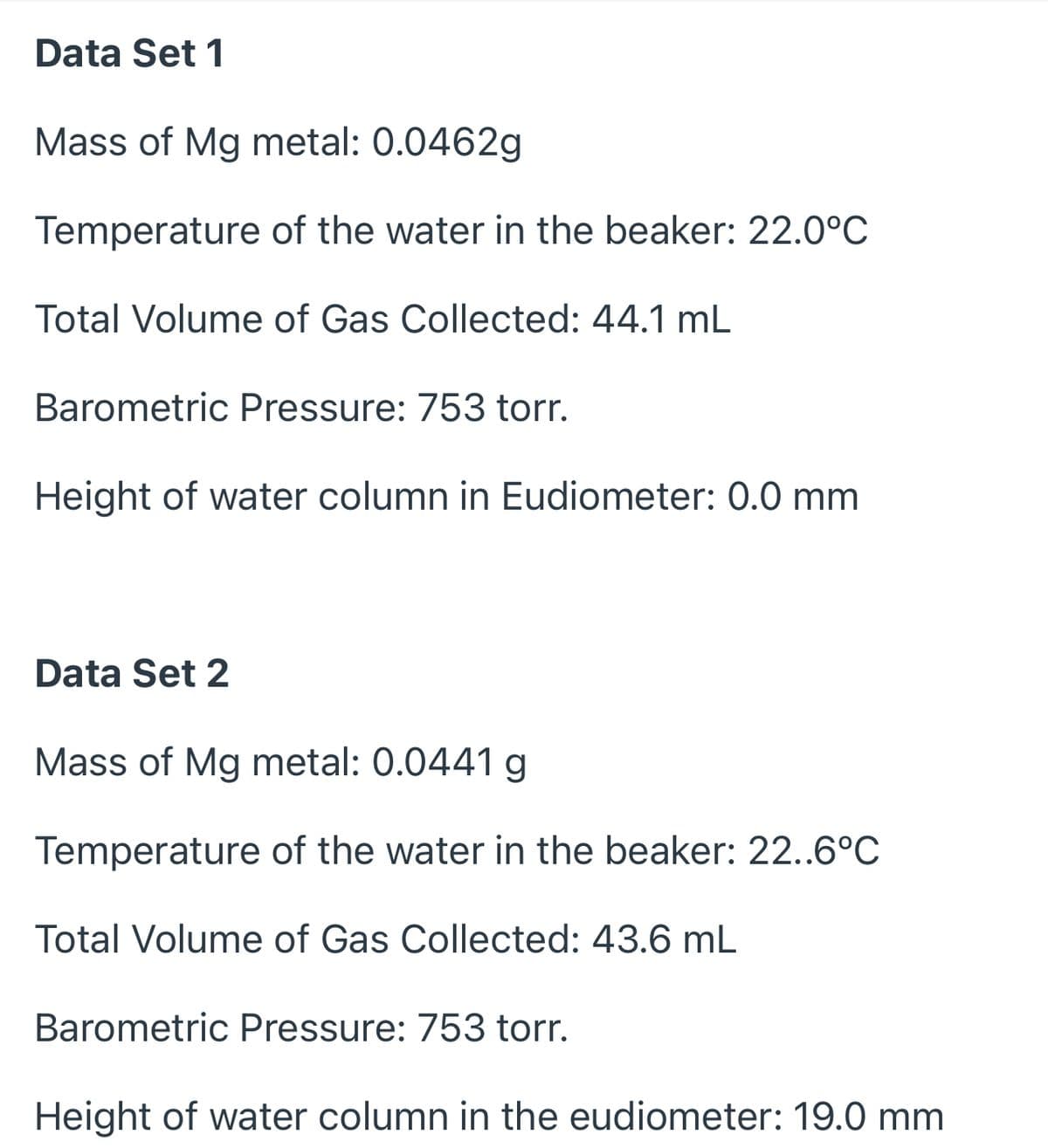Also, answer the following questions in the conclusion section of your lab notebook using complete sentences. 1. What are possible sources of error in this experiment? 2. In Data Set 2 is the pressure inside the eudiometer more or less than that of atmospheric pressure? 3. The density of water and mercury is used to convert the height of the water in the eudiometer to what the height would be if mercury were in the eudiometer instead. o Why is it necessary to do this? o What assumption is being made regarding the densities?
Also, answer the following questions in the conclusion section of your lab notebook using complete sentences. 1. What are possible sources of error in this experiment? 2. In Data Set 2 is the pressure inside the eudiometer more or less than that of atmospheric pressure? 3. The density of water and mercury is used to convert the height of the water in the eudiometer to what the height would be if mercury were in the eudiometer instead. o Why is it necessary to do this? o What assumption is being made regarding the densities?
General Chemistry - Standalone book (MindTap Course List)
11th Edition
ISBN:9781305580343
Author:Steven D. Gammon, Ebbing, Darrell Ebbing, Steven D., Darrell; Gammon, Darrell Ebbing; Steven D. Gammon, Darrell D.; Gammon, Ebbing; Steven D. Gammon; Darrell
Publisher:Steven D. Gammon, Ebbing, Darrell Ebbing, Steven D., Darrell; Gammon, Darrell Ebbing; Steven D. Gammon, Darrell D.; Gammon, Ebbing; Steven D. Gammon; Darrell
Chapter5: The Gaseous State
Section: Chapter Questions
Problem 5.145QP: A 275-mL sample of CO gas is collected over water at 31C and 755 mmHg. If the temperature of the gas...
Related questions
Question

Transcribed Image Text:Data Set 1
Mass of Mg metal: 0.0462g
Temperature of the water in the beaker: 22.0°C
Total Volume of Gas Collected: 44.1 mL
Barometric Pressure: 753 torr.
Height of water column in Eudiometer: 0.0 mm
Data Set 2
Mass of Mg metal: 0.0441 g
Temperature of the water in the beaker: 22..6°C
Total Volume of Gas Collected: 43.6 mL
Barometric Pressure: 753 torr.
Height of water column in the eudiometer: 19.0 mm
![Remember that the ratio of the density water to that of
mercury is [(1.00 g/mL)/ (13.6 g/mL)].
In your lab notebook calculate the molar volume of
the gas at STP using Data Sets 1 and then using Data
Set 2. Show your calculations in the calculation
section in your lab note book for BOTH data sets. Find
the average experimental molar volume value from
both data sets and calculate the average percent error
using the known molar volume of a gas at STP.
Also, answer the following questions in the conclusion
section of your lab notebook using complete
sentences.
1. What are possible sources of error in this
experiment?
2. In Data Set 2 is the pressure inside the
eudiometer more or less than that of
atmospheric pressure?
3. The density of water and mercury is used to
convert the height of the water in the eudiometer
to what the height would be if mercury were in
the eudiometer instead.
o Why is it necessary to do this?
o What assumption is being made regarding
the densities?](/v2/_next/image?url=https%3A%2F%2Fcontent.bartleby.com%2Fqna-images%2Fquestion%2Fc056aa58-bf9c-4143-8824-c19a449b7bda%2Fbe559206-8101-4c05-9783-723f80095d2c%2Fdd62e9s_processed.jpeg&w=3840&q=75)
Transcribed Image Text:Remember that the ratio of the density water to that of
mercury is [(1.00 g/mL)/ (13.6 g/mL)].
In your lab notebook calculate the molar volume of
the gas at STP using Data Sets 1 and then using Data
Set 2. Show your calculations in the calculation
section in your lab note book for BOTH data sets. Find
the average experimental molar volume value from
both data sets and calculate the average percent error
using the known molar volume of a gas at STP.
Also, answer the following questions in the conclusion
section of your lab notebook using complete
sentences.
1. What are possible sources of error in this
experiment?
2. In Data Set 2 is the pressure inside the
eudiometer more or less than that of
atmospheric pressure?
3. The density of water and mercury is used to
convert the height of the water in the eudiometer
to what the height would be if mercury were in
the eudiometer instead.
o Why is it necessary to do this?
o What assumption is being made regarding
the densities?
Expert Solution
This question has been solved!
Explore an expertly crafted, step-by-step solution for a thorough understanding of key concepts.
Step by step
Solved in 2 steps with 3 images

Knowledge Booster
Learn more about
Need a deep-dive on the concept behind this application? Look no further. Learn more about this topic, chemistry and related others by exploring similar questions and additional content below.Recommended textbooks for you

General Chemistry - Standalone book (MindTap Cour…
Chemistry
ISBN:
9781305580343
Author:
Steven D. Gammon, Ebbing, Darrell Ebbing, Steven D., Darrell; Gammon, Darrell Ebbing; Steven D. Gammon, Darrell D.; Gammon, Ebbing; Steven D. Gammon; Darrell
Publisher:
Cengage Learning

Introductory Chemistry: A Foundation
Chemistry
ISBN:
9781337399425
Author:
Steven S. Zumdahl, Donald J. DeCoste
Publisher:
Cengage Learning

Physical Chemistry
Chemistry
ISBN:
9781133958437
Author:
Ball, David W. (david Warren), BAER, Tomas
Publisher:
Wadsworth Cengage Learning,

General Chemistry - Standalone book (MindTap Cour…
Chemistry
ISBN:
9781305580343
Author:
Steven D. Gammon, Ebbing, Darrell Ebbing, Steven D., Darrell; Gammon, Darrell Ebbing; Steven D. Gammon, Darrell D.; Gammon, Ebbing; Steven D. Gammon; Darrell
Publisher:
Cengage Learning

Introductory Chemistry: A Foundation
Chemistry
ISBN:
9781337399425
Author:
Steven S. Zumdahl, Donald J. DeCoste
Publisher:
Cengage Learning

Physical Chemistry
Chemistry
ISBN:
9781133958437
Author:
Ball, David W. (david Warren), BAER, Tomas
Publisher:
Wadsworth Cengage Learning,

Introductory Chemistry: An Active Learning Approa…
Chemistry
ISBN:
9781305079250
Author:
Mark S. Cracolice, Ed Peters
Publisher:
Cengage Learning

Chemistry: An Atoms First Approach
Chemistry
ISBN:
9781305079243
Author:
Steven S. Zumdahl, Susan A. Zumdahl
Publisher:
Cengage Learning
